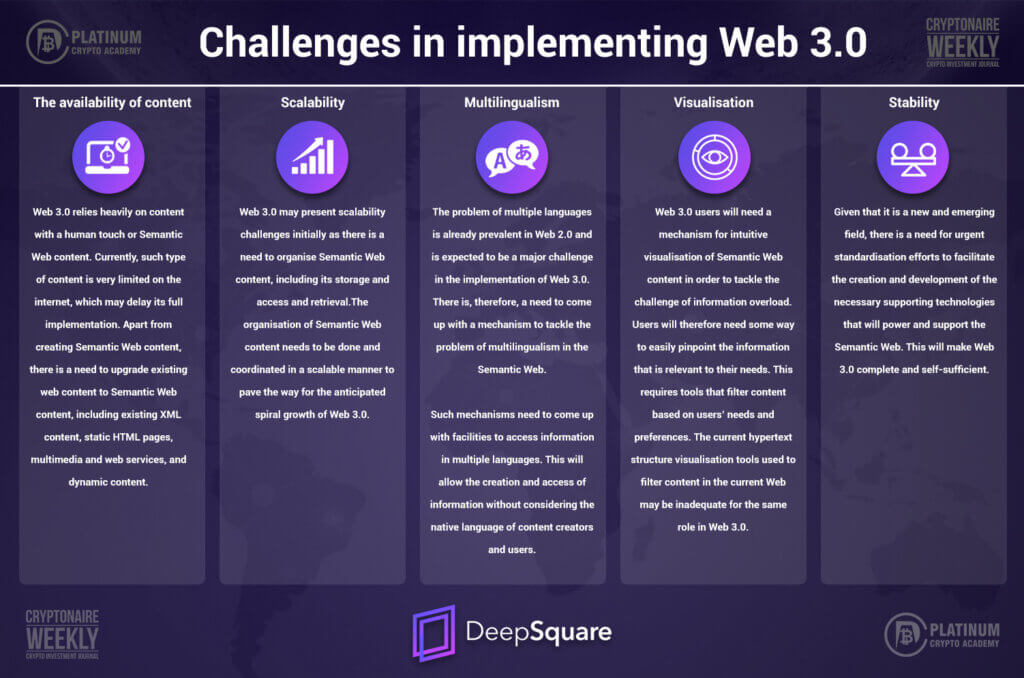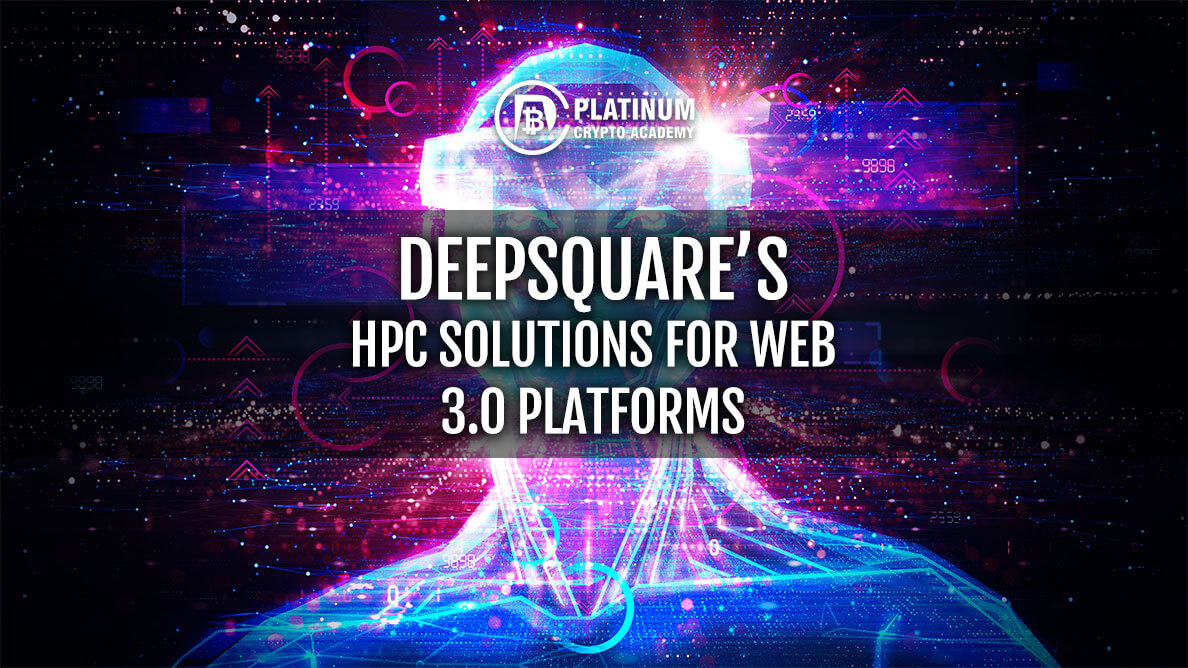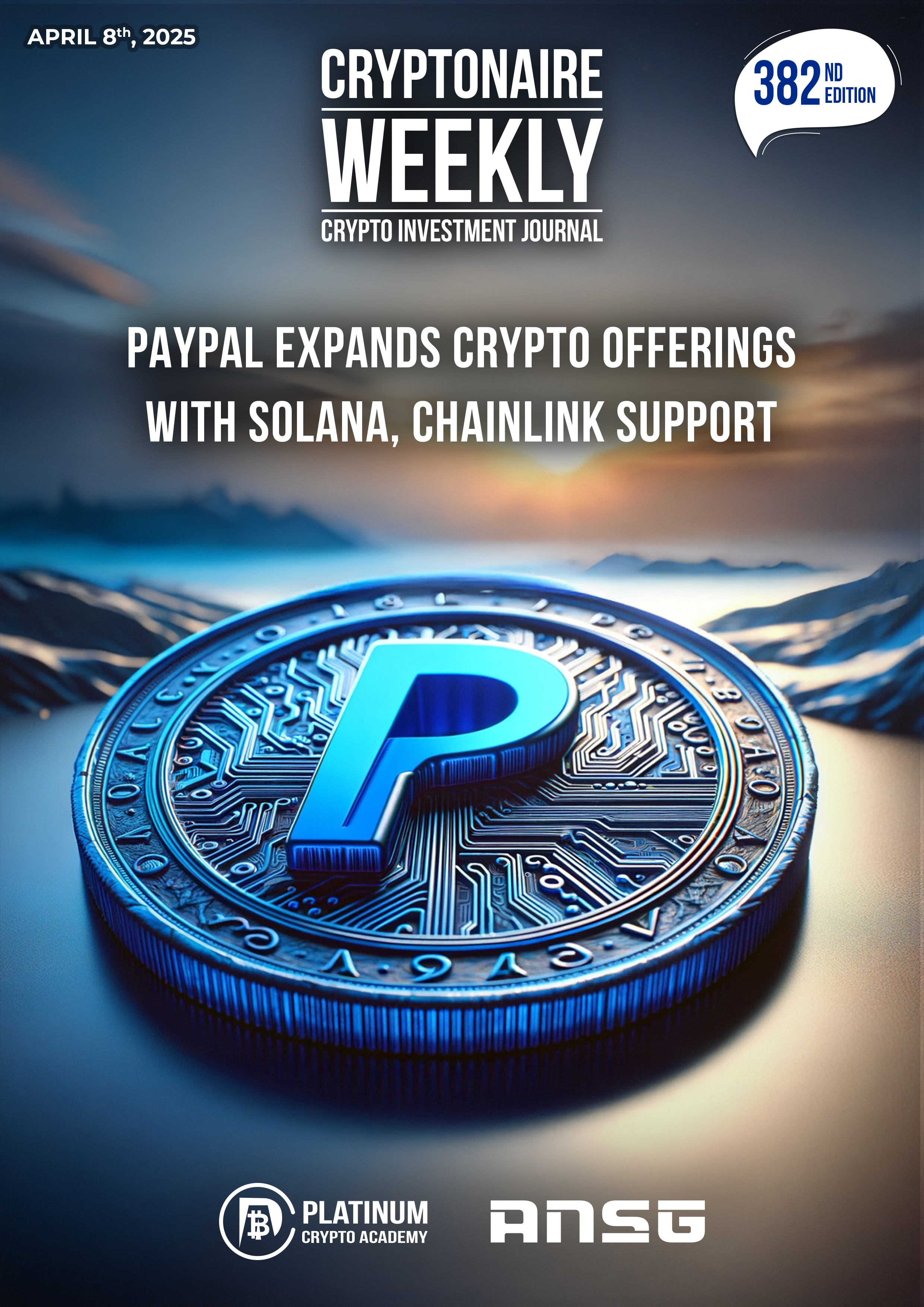Quick Links
Innovative computing technologies like Machine Learning (ML), Artificial Intelligence (AI), automation, and climate modelling consume a lot of energy, making them only accessible to ones who can afford such resources. There has always been a need for innovative technology to bridge the gap in computing efficiency and sustainability in the wake of calls to be climate-conscious.
DeepSquare is building a decentralised, responsible, and sustainable ecosystem to support high-performance computing (HPC). HPC are solutions that allow high-speed and complex calculations in data processing systems.
The DeepSquare ecosystem is made up of four ecosystem actors:
- Independent software vendors or Application Providers (ISVs)
- Facility Owners/Operators
- End-Customers
- The Community (Tokenholders)
Web 3.0
Web 3.0 is the third generation of the internet, where apps and websites will rely on technologies like machine learning (ML), Big Data, and decentralised ledger technology (DLT) to process information in a human-like manner. Initially called Semantic Web, Web 3.0 is a brainchild of World Wide Web inventor Tim Berners-Lee, and its core concepts include openness, decentralisation, and greater user utility.
Web 3.0 is poised to be the next phase of internet/web evolution and is expected to be more disruptive as well as causing a major paradigm shift from Web 2.0. The new technology is developed in such a way that it is more autonomous, intelligent, and open.
Initially, Berners-Lee envisioned the Semantic Web as a reliable way to allow computers to process and interpret semantic language by putting words and phrases in their actual context.
Web 3.0 is expected to be revolutionary by using AI systems to process information with near-human-like intelligence. Semantic Web was designed in a way that it could automatically sync with systems, people, and home devices. The new system is said to streamline content creation and decision-making by integrating the power of humans and machines.
Key Features of Web 3.0
There are four main defining features of Web 3.0:
- Decentralisation
- Trustless and permissionless
- Artificial intelligence (AI) and machine learning
- Connectivity and ubiquity
Below is a deeper dive into each of these defining features.
Decentralisation
Web 3.0 will decentralise internet services, allowing users to own and govern sections of the internet instead of accessing it through third-party companies like Google, Apple, or Facebook. Users will, therefore, be able to interact with one another without going through centralised authorities and third-party intermediaries.
In Web 2.0, information is found in one location and can be accessed through unique HTTP encryptions. On the other hand, in Web 3.0, information is located in diverse, decentralised locations and can be accessed based on the content itself.
Decentralisation is expected to break down the huge databases that companies like Google and Facebook hold and put more data in the hands of individual users. This offers users greater control of their data and prevents data breaches and undue enrichment by third-party companies.
Web 3.0 will allow users to monetise their data collected from various sources, including desktops, mobile phones, vehicles, appliances, and sensors, through decentralised data networks.
Trustless and Permissionless
Blockchain is a major aspect of Web 3.0 and developers are using the technology to create open and transparent databases that will form the bedrock of Web 3.0. The new network will allow providers and users to interact without needing a trusted intermediary, i.e. trustless. In addition, participants will also interact without seeking permission from a governing body, i.e. permissionless.
Blockchain allows parties to exchange data and transact securely and transparently. The data exchanged can be accessed by all computers connected to the decentralised network without seeking permission from a centralised organisation. Additionally, any individual on the network can edit the data, and the changes made are reflected to all players connected to the network, making the system immutable, secure, and transparent.
Artificial intelligence (AI) and machine learning
Web 3.0 will integrate technologies that support Semantic Web concepts and natural language processing in order to facilitate faster validation and delivery of information to the users. The network will use technologies like artificial intelligence, which allows computers to replicate the human mind.
AI will therefore help Web 3.0 to read and decipher the meaning and emotions conveyed in a certain set of data. While today’s internet can understand syntax rules – the grammar – Web 3.0 will understand semantic rules too, allowing computers to process and understand the context, the implications, the emotion, and the slang that comes with human language.
To further improve accuracy, Web 3.0 will incorporate machine learning, which uses algorithms and data to imitate how humans learn. This will enable computers to produce relevant results much faster and accurately in several areas.
Connectivity and ubiquity
Web 3.0 allows access to content and data on multiple applications and devices. The network is also accessible to everyone anywhere, anytime, regardless of whether you are using a computer or a smartphone.
The network is also flexible enough and will be able to accommodate more internet-connected devices and intelligent gadgets beyond computers and smartphones.
How is Web 3.0 different from Web 2.0?
The internet as we know it today has developed and evolved in different phases and milestones over the years to reach where it is now. Web 2.0 and Web 3.0 are simply generations of internet services, with distinct features and variations in how users interact and share information on the internet.
Web 2.0 refers to the normal World Wide Web, also called a participative social web, as it relies on user-generated content, interoperability, and usability for the end-users. This network is mainly focused on enabling internet users to interact with content on the Web.
Web 2.0 focuses less on modifying any technical specifications and more on changing web page designs and the way they are used. The network has encouraged interaction and collaborations among users in P2P transactions and led to mushrooming of social media and e-commerce platforms.
To create and develop Web 2.0 websites, you need web browser technologies like AJAX and JavaScript.
Main features of Web 2.0
- Allows free information sorting where users can collectively retrieve and classify information.
- Web 2.0 focuses on dynamic content that is responsive to user input.
- It has a greater emphasis on evaluation and online commenting to facilitate engagement and information flow between site owners and site users.
- Users can access web content from personal computers, mobile devices, televisions, multimedia consoles, and other internet-enabled devices.
- It is a participative social web where users can contribute to creating and sharing responsive content and offer favourable opportunities for collaboration.
Summary of differences between Web 2.0 and Web 3.0
- Web 2.0 is the second generation of the internet, where the main focus is interaction. On the other hand, Web 3.0 is the third generation of the internet mainly focused on decentralisation and semantic learning.
- Web 2.0 is mainly focused on community development, while Web 3.0’s main focus is to empower individual users.
- Web 2.0 relies on internet technologies like AJAX, JavaScript, HTML5, CSS3, while Web 3.0 relies on artificial intelligence, machine learning, and decentralised protocols.
- Web 2.0 mainly relies on web applications, while Web 3.0 relies on smart applications based on artificial intelligence and machine learning.
- In the Web 2.0 ecosystem, the network owns the data, while in Web 3.0, entities and individuals are in charge of their data and control its use and sharing.
While Web 2.0 uses ReadWrite Web, web applications, viral media, blogs, rich media, tagging, and folksonomy to share information in communities, Web 3.0 uses Semantic Web, drag and drop mashups, widgets, advertisement, and user engagement.
Web 3.0 has a stronger promise to the future as it uses the semantic approach to allow users to experience several widgets and knowledge bases. In addition, Web 3.0 offers personal assistance and data customised to individual user needs.
Challenges in implementing Web 3.0

While Web 3.0 promises to unlock many opportunities, its success will largely depend on the availability of high-quality and diverse content. Several challenges that still stand in its way to successful implementation. Below is a detailed overview of these challenges:
The availability of content
Web 3.0 relies heavily on content with a human touch or Semantic Web content. Currently, such type of content is very limited on the internet, which may delay its full implementation. Apart from creating Semantic Web content, there is a need to upgrade existing web content to Semantic Web content, including existing XML content, static HTML pages, multimedia and web services, and dynamic content.
Scalability
Web 3.0 may present scalability challenges initially as there is a need to organise Semantic Web content, including its storage and access and retrieval.The organisation of Semantic Web content needs to be done and coordinated in a scalable manner to pave the way for the anticipated spiral growth of Web 3.0.
Multilingualism
The problem of multiple languages is already prevalent in Web 2.0 and is expected to be a major challenge in the implementation of Web 3.0. There is, therefore, a need to come up with a mechanism to tackle the problem of multilingualism in the Semantic Web.
Such mechanisms need to come up with facilities to access information in multiple languages. This will allow the creation and access of information without considering the native language of content creators and users.
Visualisation
Web 3.0 users will need a mechanism for intuitive visualisation of Semantic Web content in order to tackle the challenge of information overload. Users will therefore need some way to easily pinpoint the information that is relevant to their needs. This requires tools that filter content based on users’ needs and preferences. The current hypertext structure visualisation tools used to filter content in the current Web may be inadequate for the same role in Web 3.0.
Stability
Given that it is a new and emerging field, there is a need for urgent standardisation efforts to facilitate the creation and development of the necessary supporting technologies that will power and support the Semantic Web. This will make Web 3.0 complete and self-sufficient.
How DeepSquare addresses some of these challenges
DeepSquare is working to create a bridge between traditional business and the revolutionary world of blockchain and offer an ecosystem that meets the needs for high-performance computing (HPC) while sustainably and efficiently supporting innovation. It is a perfect solution for entities facing high and intensive computing demand.
While it is designed to be virtual, Web 3.0 is not entirely so, as it depends on energy drawn from the physical world. Since its inception, one of the major challenges that have faced the blockchain world is its huge energy consumption that in some territories has put national grids in jeopardy and amplified calls for increased state regulation.
Again, there are growing calls to embrace energy-efficient technologies in order to tame climate change before it spirals out of control. Web 3.0 is projected to increase the number of organisations with high-performance computing as a service (HPCaaS), which involves offering high-level processing capacity to customers to support scientific computing and big data analysis running high-performance computing (HPC). This trend will no doubt increase the level of energy consumption.
DeepSquare offers hyper-efficient, optimised solutions for organisations that rely on high-performance computing (HPC). These solutions involve utilising a mix of renewable energy and the latest technologies in cooling technology and heat recovery to reduce energy demands and ensure the highest level of sustainability. DeepSquare will allow Web 3.0 to to develop in a truly sustainable manner.
Conclusion
While Web 3.0 is projected to be a game-changer in many facets of the internet world, there is a need to lay strong infrastructure to support the system with minimal impact on climate. Services like DeepSquare should come in handy as a backup service to support the successful implementation and transition to the revolutionary World Web 3.0.
Hopefully, you have enjoyed today’s article. Thanks for reading! Have a fantastic day! Live from the Platinum Crypto Trading Floor.
Earnings Disclaimer: The information you’ll find in this article is for educational purpose only. We make no promise or guarantee of income or earnings. You have to do some work, use your best judgement and perform due diligence before using the information in this article. Your success is still up to you. Nothing in this article is intended to be professional, legal, financial and/or accounting advice. Always seek competent advice from professionals in these matters. If you break the city or other local laws, we will not be held liable for any damages you incur.


